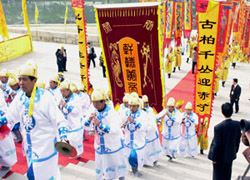More than 5,000 Chinese gathered in front of the Yellow
Emperor's Mausoleum on Tuesday in Huangling, Shaanxi Province, to
pay their respects to the legendary father of the Chinese
nation.
The crowd included a special delegation from Taiwan led by John
Chiang Hsiao-yen, Kuomintang Central Standing Committee member and
grandson of the late Kuomintang chairman Chiang Kai-shek.
The ceremonies are held annually on
Qingming Festival, a traditional day for the Chinese to pay
homage to their ancestors.
Chiang and his delegation arrived in Xi'an, the capital of
northwest China's
Shaanxi
Province, on Monday evening.
He said he was attending the ceremony both as a Chinese and as a
member of the Kuomintang Central Standing Committee.
"It is very significant to be here to attend the ceremony.
People on both sides of the Taiwan Straits are Chinese. Nothing
can, or should, separate them from each other, from the same root,
the same clan and the same ancestor. Blood is always thicker than
water," he said.

Chiang expressed
the hope that charter flights between the mainland and Taiwan will
be expanded to include all travelers with valid certificates,
rather than solely to Taiwanese businesspeople on the mainland.
"We must maintain peace and exchanges between the two sides and
make progress step by step," he said.
Chen Deming, governor of Shaanxi Province, said that
reunification of the motherland would be the best way to honor the
Yellow Emperor's memory.
A central government delegation led by Xu Jialu, vice chairman
of the Standing Committee of the National People's Congress, and
Liu Yandong, vice chairwoman of the National Committee of the
Chinese People's Political Consultative Conference, also attended
the ceremony.
The Taiwan delegation will participate in various economic and
trade activities organized by the local government during its stay
in Shaanxi.

The Yellow
Emperor, a great tribal chief of China's prehistory, is recognized
as the first sovereign of civilized China. He is credited with such
inventions as the cart, boat, bow and arrow and Chinese medicine.
One of his imperial historians is believed to have created Chinese
pictography.
Since 1992, 130 million yuan (US$15.7 million) from the central
and local governments, companies and individuals has been spent on
renovating the mausoleum.

(China Daily April 6, 2005)